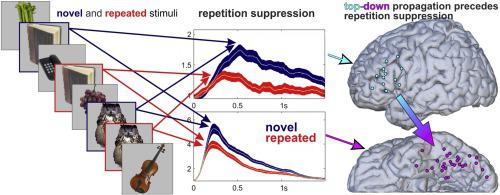当前位置:
X-MOL 学术
›
Prog. Neurobiol.
›
论文详情
Our official English website, www.x-mol.net, welcomes your
feedback! (Note: you will need to create a separate account there.)
Changes in human brain dynamics during behavioral priming and repetition suppression.
Progress in Neurobiology ( IF 6.7 ) Pub Date : 2020-03-18 , DOI: 10.1016/j.pneurobio.2020.101788 Anna Korzeniewska 1 , Yujing Wang 1 , Heather L Benz 1 , Matthew S Fifer 1 , Max Collard 1 , Griffin Milsap 1 , Mackenzie C Cervenka 1 , Alex Martin 2 , Stephen J Gotts 2 , Nathan E Crone 1
Progress in Neurobiology ( IF 6.7 ) Pub Date : 2020-03-18 , DOI: 10.1016/j.pneurobio.2020.101788 Anna Korzeniewska 1 , Yujing Wang 1 , Heather L Benz 1 , Matthew S Fifer 1 , Max Collard 1 , Griffin Milsap 1 , Mackenzie C Cervenka 1 , Alex Martin 2 , Stephen J Gotts 2 , Nathan E Crone 1
Affiliation

|
Behavioral responses to a perceptual stimulus are typically faster with repeated exposure to the stimulus (behavioral priming). This implicit learning mechanism is critical for survival but impaired in a variety of neurological disorders, including Alzheimer's disease. Many studies of the neural bases for behavioral priming have encountered an interesting paradox: in spite of faster behavioral responses, repeated stimuli usually elicit weaker neural responses (repetition suppression). Several neurophysiological models have been proposed to resolve this paradox, but noninvasive techniques for human studies have had insufficient spatial-temporal precision for testing their predictions. Here, we used the unparalleled precision of electrocorticography (ECoG) to analyze the timing and magnitude of task-related changes in neural activation and propagation while patients named novel vs repeated visual objects. Stimulus repetition was associated with faster verbal responses and decreased neural activation (repetition suppression) in ventral occipito-temporal cortex (VOTC) and left prefrontal cortex (LPFC). Interestingly, we also observed increased neural activation (repetition enhancement) in LPFC and other recording sites. Moreover, with analysis of high gamma propagation we observed increased top-down propagation from LPFC into VOTC, preceding repetition suppression. The latter results indicate that repetition suppression and behavioral priming are associated with strengthening of top-down network influences on perceptual processing, consistent with predictive coding models of repetition suppression, and they support a central role for changes in large-scale cortical dynamics in achieving more efficient and rapid behavioral responses.
中文翻译:

行为启动和重复抑制过程中人脑动力学的变化。
反复暴露于刺激下(行为引发),对知觉刺激的行为反应通常更快。这种隐式的学习机制对生存至关重要,但会在包括阿尔茨海默氏病在内的多种神经系统疾病中受损。关于行为启动的神经基础的许多研究都遇到了一个有趣的悖论:尽管行为反应更快,但是重复刺激通常会引起较弱的神经反应(重复抑制)。已经提出了几种神经生理学模型来解决这一矛盾,但是用于人类研究的非侵入性技术的时空精度不足以检验其预测。这里,我们使用无与伦比的脑皮质描记术(ECoG)精度来分析与任务相关的神经激活和传播变化的时机和幅度,而患者将其命名为新型视觉对象还是重复性视觉对象。刺激重复与更快的言语反应和腹侧枕颞皮层(VOTC)和左前额叶皮层(LPFC)的神经激活(重复抑制)减少有关。有趣的是,我们还观察到了LPFC和其他记录位点中神经激活(重复增强)的增加。此外,通过对高伽马传播的分析,我们观察到在重复抑制之前,从LPFC到VOTC的自顶向下传播有所增加。后一项结果表明,重复抑制和行为启动与自上而下的网络对感知处理的影响增强有关,
更新日期:2020-03-18
中文翻译:

行为启动和重复抑制过程中人脑动力学的变化。
反复暴露于刺激下(行为引发),对知觉刺激的行为反应通常更快。这种隐式的学习机制对生存至关重要,但会在包括阿尔茨海默氏病在内的多种神经系统疾病中受损。关于行为启动的神经基础的许多研究都遇到了一个有趣的悖论:尽管行为反应更快,但是重复刺激通常会引起较弱的神经反应(重复抑制)。已经提出了几种神经生理学模型来解决这一矛盾,但是用于人类研究的非侵入性技术的时空精度不足以检验其预测。这里,我们使用无与伦比的脑皮质描记术(ECoG)精度来分析与任务相关的神经激活和传播变化的时机和幅度,而患者将其命名为新型视觉对象还是重复性视觉对象。刺激重复与更快的言语反应和腹侧枕颞皮层(VOTC)和左前额叶皮层(LPFC)的神经激活(重复抑制)减少有关。有趣的是,我们还观察到了LPFC和其他记录位点中神经激活(重复增强)的增加。此外,通过对高伽马传播的分析,我们观察到在重复抑制之前,从LPFC到VOTC的自顶向下传播有所增加。后一项结果表明,重复抑制和行为启动与自上而下的网络对感知处理的影响增强有关,







































 京公网安备 11010802027423号
京公网安备 11010802027423号